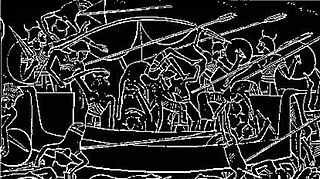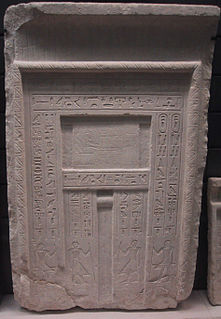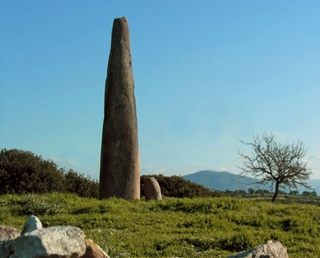Related Research Articles

Archaeological evidence of prehistoric human settlement on the island of Sardinia is present in the form of nuraghes and other prehistoric monuments, which dot the land. The recorded history of Sardinia begins with its contacts with the various people who sought to dominate western Mediterranean trade in Classical Antiquity: Phoenicians, Punics and Romans. Initially under the political and economic alliance with the Phoenician cities, it was partly conquered by Carthage in the late 6th century BC and then entirely by Rome after the First Punic War. The island was included for centuries in the Roman province of Sardinia and Corsica, which would be incorporated into the diocese of Italia suburbicaria in 3rd and 4th centuries.

The Sherden are one of the several ethnic groups the Sea Peoples were said to be composed of, appearing in fragmentary historical and iconographic records from the Eastern Mediterranean in the late 2nd millennium BC.

A megalith is a large stone that has been used to construct a prehistoric structure or monument, either alone or together with other stones. There are over 35,000 in Europe alone, located widely from Sweden to the Mediterranean sea.

Neolithic Europe is the period when Neolithic technology was present in Europe, roughly between 7000 BCE and c. 2000-1700 BCE. The Neolithic overlaps the Mesolithic and Bronze Age periods in Europe as cultural changes moved from the southeast to northwest at about 1 km/year – this is called the Neolithic Expansion.

Domus de Janas are a type of pre-Nuragic chamber tombs found in Sardinia. They consist of several chambers quarried out by the people of the San Ciriaco through Ozieri cultures and subsequent cultures, resembling houses in their layout.

Sulcis is a subregion of Sardinia, Italy, in the Province of South Sardinia.

A false door, or recessed niche, is an artistic representation of a door which does not function like a real door. They can be carved in a wall or painted on it. They are a common architectural element in the tombs of ancient Egypt, but appeared possibly earlier in some Pre-Nuragic Sardinian tombs. Later they also occur in Etruscan tombs and in the time of ancient Rome they were used in the interiors of both houses and tombs.

The prehistory of Italy began in the Paleolithic period, when species of Homo colonized the Italian territory for the first time, and ended in the Iron Age, when the first written records appeared in Italy.

The prehistory of Corsica is analogous to the prehistories of the other islands in the Mediterranean Sea, such as Sicily, Sardinia, Malta and Cyprus, which could only be accessed by boat and featured cultures that were to some degree insular; that is, modified from the traditional Paleolithic, Mesolithic, Neolithic and Chalcolithic of European prehistoric cultures. The islands of the Aegean Sea and Crete early developed Bronze Age civilizations and are accordingly usually treated under those categories. Stone Age Crete however shares some of the features of the prehistoric Mediterranean islands.

The Nuragic civilization, also known as the Nuragic culture, was a civilization or culture on Sardinia (Italy), the second largest island in the Mediterranean Sea, which lasted from the 18th century BC up to the Roman colonization in 238 BC. Others date the culture as lasting at least until the 2nd century AD and in some areas, namely the Barbagia, to the 6th century AD or possibly even to the 11th century AD.

Monte d'Accoddi is a Neolithic archaeological site in northern Sardinia, located in the territory of Sassari. The site consists of a massive raised stone platform thought to have been an altar. It was constructed by the Ozieri culture or earlier, with the oldest parts dated to around 4,000–3,650 BC.

The Bonnanaro culture is a protohistoric culture that flourished in Sardinia during the 2nd millennium BC, considered to be the first stage of the Nuragic civilization. It takes its name from the comune of Bonnanaro in the province of Sassari where in 1889 the eponymous site was discovered.

The Giants of Mont'e Prama are ancient stone sculptures created by the Nuragic civilization of Sardinia, Italy. Fragmented into numerous pieces, they were discovered in March 1974 on farmland near Mont'e Prama, in the comune of Cabras, province of Oristano, in central-western Sardinia. The statues are carved in local sandstone and their height varies between 2 and 2.5 meters.

The Sacred pit of Garlo is an archaeological site near the village of Garlo in Pernik District, Bulgaria.

The Pre-Nuragic period refers to the prehistory of Sardinia from the Paleolithic until the middle Bronze Age, when the Nuragic civilization flourished on the island.

The Beaker culture in Sardinia appeared circa 2100 BC during the last phase of the Chalcolithic period. It initially coexisted with and then replaced the previous Monte Claro culture in Sardinia, developing until the ancient Bronze Age circa 1900–1800 BC. Then, the Beaker culture mixed with the related Bonnanaro culture, considered the first stage of the Nuragic civilization.

The Bonuighinu culture or Bonu Ighinu culture, sometimes also called Bonu Ighinu Phase, is a middle neolithic, pre-Nuragic culture from Sardinia and roughly dates to the first half of the 5th millennium BC. It takes its name from a locality in the municipality of Mara, province of Sassari, where the cave of Sa de Ucca of Tintirriolu is located. The first Bonu Ighinu pottery was discovered here by Renato Loria and David H. Trump in 1971.

The Civic Archaeological Museum "Alle Clarisse" of Ozieri is one of the most important museums in Northern Sardinia. Since 2003 it has been transferred to the former Poor Clares' convent. Its showcases contain the most significant finds found in the municipal area of Ozieri: the materials on display date from prehistoric times to the Modern Age.
References
- ↑ Lugliè, Carlo (2018). "Your path led trough [sic] the sea … The emergence of Neolithic in Sardinia and Corsica". Quaternary International. 470: 285–300. Bibcode:2018QuInt.470..285L. doi:10.1016/j.quaint.2017.12.032.
- ↑ Webster, Gary (2019). The Sardinian Neolithic: An Archaeology of the 6th and 5th Millennia BCE. BAR int. ser. 2941. Oxford: BAR Publishing. p. 66. ISBN 9781407355115.
- ↑ Webster, Gary (2019). The Sardinian Neolithic: An Archaeology of the 6th and 5th Millennia BCE. Oxford: BAR Publishing. p. 63. ISBN 9781407355115.
- ↑ Webster, Gary (2019). The Sardinian Neolithic: An Archaeology of the 6th and 5th Millennia BCE. BAR int. ser. 2941. Oxford: BAR Publishing. p. 72. ISBN 9781407355115.
- ↑ Webster, Gary (2019). The Sardinian Neolithic: An Archaeology of the 6th and 5th Millennia BCE. BAR int. ser. 2941. Oxford: BAR Publishing. p. 67. ISBN 9781407355115.